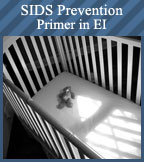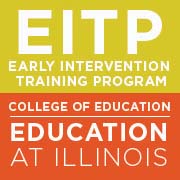SIDS Primer in the Early Intervention Setting
Course Outcomes:
Please scroll down for outcomes per discipline and other information, such as Target Audience, Course Content and Level
Course intent: To provide speech language pathologists & occupational therapists, as well as other early intervention providers with the clinical background to understand the clinically relevant issues regarding SIDS so as to by virtue of their front-line entry access into home of very young children educate, and help prevent occurrence/recurrence by virtue of their role as an early intervention provider providing early intervention in the home setting or facility based program.
Relevance to occupational, speech language pathology, physical therapy & other early intervention providers: Aforementioned disciplines therapists and other early intervention providers treating children between the ages of 0-3 are on the front line of treating children who may be at risk for SIDS, especially when visiting the home in the early intervention setting.
Outcomes:
Provider will be able to: Identify the epidemiology, preventable risk factors for both mother and child, and understand the triple-risk model which can often be mitigated by early intervention providers by virtue of their role in the home
Provider will be able to: Identify the etiology, role of sleep posture, and dangers of bottle propping for SIDS
Provider will be able to: Identify the role of position aspiration, reflux, GERD, apnea, 2nd hand smoke and re-breathing as contributing and causative factors in SIDS
Provider will be able to: Identify the role of the reticular activating system in pre-mature babies, and its relation to SIDS
Provider will be able to: Identify the catalyst for the American Academy of Pediatrics� Safe to Sleep initiative, and why early intervention providers can directly impact on life saving education and the implementation of safe and preventative practice
Provider will be able to: Identify why SIDS is a diagnosis of exclusion, and how the role of an early intervention provider, by virtue of their presence and education can ward off both SIDS and SUID
Provider will be able to: fulfill their State obligatory imperative, based upon State early intervention regulations, that all early intervention providers be actively involved in a preventative manner, and be ready to react in a life-saving manner via education &/or communication with early intervention service coordinators and officials with respect to the childs health and safety
Provider will be able to: Identify the ethical constraints & professional obligations imperative to early intervention professionals with respect to reporting suspicion of, or incidents of SIDS, as well as interventional prevention.
Speech Language Pathology
Target Audience: Speech Language Pathologists, Speech teachers and Audiologists, Occupational therapists, COTA's, PT, PTA, SW, SE,SI
Course Level: Various Content: Related
Subject Code: 7060 Patient/Client Safety and Prevention of Medical Errors
Domain of Occupational Therapy:
- Areas of Occupation
- IADL
- Occupational Therapy Process
- Intervention: Health Promotion
- Professional Issues
- Contemporary Issues & Trends
- Professional Development and Continued Competency
Target level: All practitioners working in the 0 - 3 population
Prerequisites: None; beginner
Agenda:
Introduction
SIDS: More Common Today
Triple Risk Model
SUIDS
Risk Factors
Supine Sleeping & Aspiration
Infantile Reflux, GERD, & Sleep Postures in Babies
Apnea
RAS & SIDS
Re-Breathing and SIDS
Smoking & SIDS
Cardiac Causes of SIDS
Diagnosis
Putative Terminal Respiratory Pathway
Infanticide
State Regulations & Legislation
Back Versus Stomach Sleeping
Role of Early Intervention Providers
Infant Sleep Practices
Pro-Active Prevention
Prevention of SIDS









